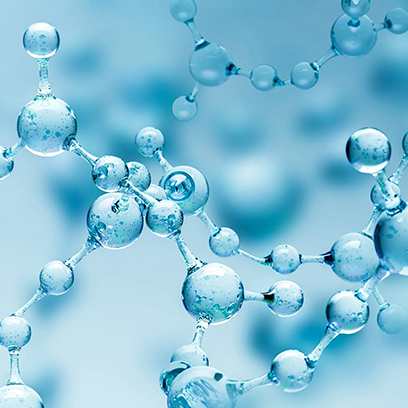HYALURONIC ACID
Hyaluronic Acid has the peculiarity of chemically binding with water and the ability to retain it within its structure. Its molecules are capable of retaining an infinitely greater amount of water than their weight. This means that hyaluronic acid is effectively used when it is necessary to retain water in the tissues, and its use is widespread in cosmetics to increase skin hydration. But this “water saver” capacity is particularly useful when it is necessary to lubricate organic structures. This is the case for those conditions in which the lack of collagen makes the friction between the joint joints painful, a condition typical of osteoarthritis and knee disease.
This hydrophilic molecule that can even weigh millions of Daltons (the measure of molecular weight) binds to other molecules building an elastic and solid network that provides tissue consistency, reduces evaporation and supports the production of the collagen protein which makes it elastic not only the epidermis but the bone and joint structures.
In the connective tissue, hyaluronic acid gives hydration, turgidity, plasticity and viscosity since it is arranged in space in an aggregate conformation, thus storing a considerable number of water molecules. It is also capable of acting as a cementing substance and as an anti-shock molecule as well as an efficient lubricating agent, for example in synovial fluid, preventing damage to tissue cells and structures from physical contact stress.
Sodium hyaluronate is the water-soluble form of hyaluronic acid, which is not soluble in water. Sodium hyaluronate is therefore the ionized form of hyaluronic acid with a neutral pH of pH7. It is therefore hyaluronic acid converted into saline form and therefore water soluble which can be returned to the human body for the synthesis of collagen which over the years impoverishes its genetic heritage and loses the ability to produce it naturally.
Used in: Pinelli Flexi Project™
READ SCIENTIFIC PUBLICATIONS ON HYALURONIC ACID
- Efficacy and safety of repeated courses of hyaluronic acid injections for knee osteoarthritis: A systematic review
- Intraarticular Hyaluronic Acid Preparations for Knee Osteoarthritis: Are Some Better Than Others?
- The comparison effects of intra-articular injection of Platelet Rich Plasma (PRP), Plasma Rich in Growth Factor (PRGF), Hyaluronic Acid (HA), and ozone in knee osteoarthritis; a one year randomized clinical trial
- Use of Intraarticular Hyaluronic Acid in the Management of Knee Osteoarthritis in Clinical Practice
- Hyaluronic acid and platelet-rich plasma for the management of knee osteoarthritis
- Procedural Treatments for Knee Osteoarthritis: A Review of Current Injectable Therapies
- Self-assembled hyaluronic acid nanoparticles for osteoarthritis treatment
- Why we should definitely include intra-articular hyaluronic acid as a therapeutic option in the management of knee osteoarthritis: Results of an extensive critical literature review

